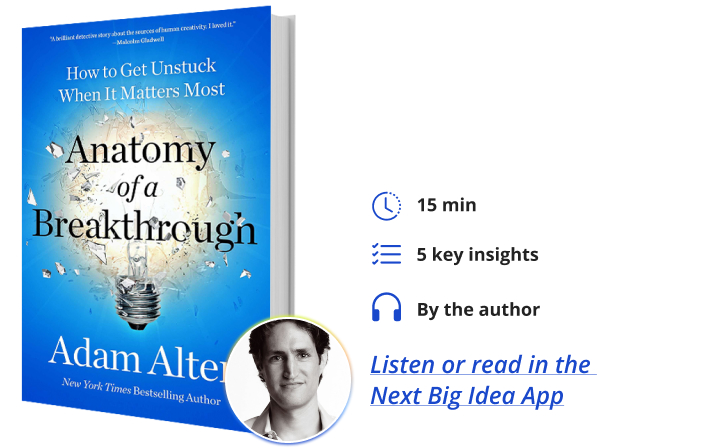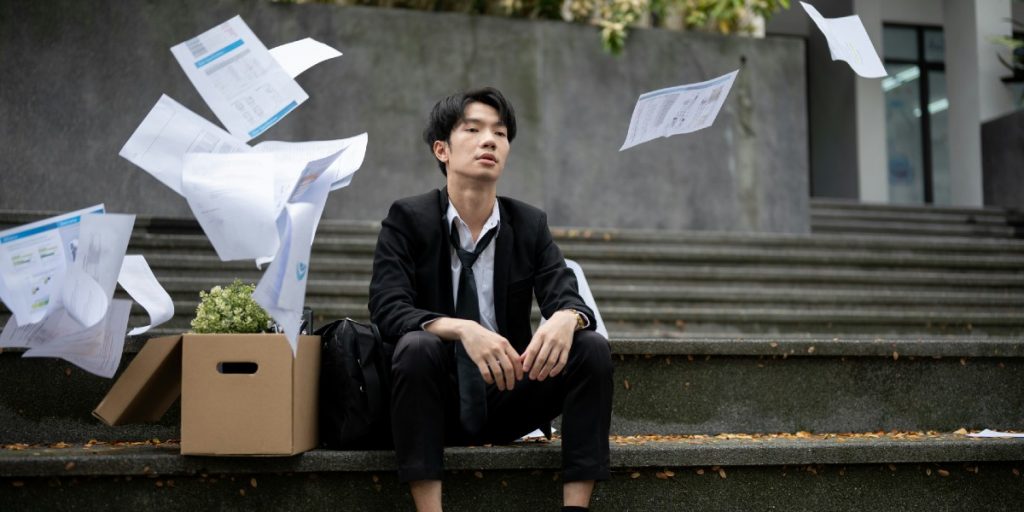Adam Alter is a professor of marketing and psychology at NYU’s Stern School of Business, and the New York Times bestselling author of Irresistible and Drunk Tank Pink.
Below, Adam shares five key insights from his new book, Anatomy of a Breakthrough: How to Get Unstuck and Thrive When It Matters Most. Listen to the audio version—read by Adam himself—in the Next Big Idea App.

1. Forecasting change is the first step to getting unstuck.
About fifteen years ago I was studying how people around the world perceive change. I discovered in East Asia—China, Japan, and South Korea, for example—people expect change all the time. When financial stocks go up, they expect them to tumble imminently; when they plummet, they expect those stocks to appreciate in value; when it’s rainy they expect it to be sunny tomorrow.
In contrast, in the U.S. and other Western countries, we expect things to remain as they are right now. We expect sunny days and rainy days to continue, and financial stocks to keep performing the way they have in the past. Our inability to forecast change is a relatively recent phenomenon. With the rise of science and advanced medicine, and the decline of religious affiliation, we’ve developed the illusion that unending progress is a birthright, and that we have far more control over the world than we do.
Just as the human lifespan has grown and we’ve developed tools to cope with ailments that plagued our ancestors, we’ve come to believe that we have agency over our fortunes. As a result, we’re blindsided by change, which is a problem because change happens all the time. We change jobs, move to new neighborhoods, make and lose friends. Some changes are good, but others are inconvenient or unwanted, and those changes cause us to feel stuck. If we expect things to stay as they are, we’re poorly prepared to act when we find ourselves stuck. The first step in managing change is to anticipate it—to recognize that it happens constantly and prepare for it rather than experiencing each new instance as a fresh shock.
2. Recombination over radical originality.
In art, music, writing, and business, the holy grail is an original idea—something revolutionary that no one’s considered before. The problem with ideas that appear revolutionary is that they’re almost never truly original. Instead, they’re what’s known as recombinations—the marriage of two old ideas to form something evolutionarily different.
“When striving for new ideas, do as Dylan did by taking two or more good but disparate concepts, and seeing if you can merge them to form a novel recombination.”
Take the case of Bob Dylan. Many of the world’s great creative minds identify Dylan as a truly original musician of the 20th Century—someone who did something genuinely new. Filmmaker David Lynch said of Dylan, “There’s no one like him. He’s unique and just way cool.” Hall of famer Jackson Brown explained that Dylan, “changed all the rules about what it meant to write songs.” For all his originality, though, Dylan borrowed many of his best ideas from rock, pop, folk, and blues artists. One of his great songwriting triumphs, Blowin’ in the Wind, was an evolutionary tweak over an antislavery hymn called No More Auction Block for Me, sung by an artist named Odetta. In 2008, Odetta laughed when asked if Dylan had “stolen” from her. “No, no, no,” she said. “We call it ‘passing on the folk tradition’…I can’t take credit for how he heard something.” Dylan later admitted his song was a marriage of worlds—of Odetta’s antislavery hymn, of traditional folk, and of biblical rhetoric.
When striving for new ideas, do as Dylan did by taking two or more good but disparate concepts, and seeing if you can merge them to form a novel recombination. That’s the origin of many successful businesses and creative products, and it’s a much lower, attainable bar than revolutionary originality.
3. Pause to move forward.
The road to breakthroughs is a series of Zen paradoxes. One of my favorites is the idea that pausing is the best way to move forward in the long run. The idea here is to take a beat—whether a minute or a day or a week—before you act.
The best examples of this come from elite athletes who sacrifice immediate performance for long-term dominance. For example, the greatest soccer player today (and perhaps ever), Lionel Messi, walks for the first few minutes of every game as he soothes his nerves and develops a sense of how the other 21 players on the field are behaving. He has never scored during the first two minutes of any game but has scored during every single other minute from three to ninety. That two-minute sacrifice pays dividends during the remaining eighty-eight-plus.
“The idea here is to take a beat—whether a minute or a day or a week—before you act.”
Tennis great Andre Agassi used a similar approach. In the late 1980s, Agassi lost his first three matches against Boris Becker, a young player with a massive serve. “His service motion was something the world had never seen before,” Agassi said later. During their fourth match, Agassi stared closely at Becker as he served, sacrificing a couple of points in pursuit of an edge. By slowing down, he discovered that Becker’s tongue flicked out of his mouth in the direction he planned to serve, and so Agassi went on to dominate Becker’s serve and win nine of the next eleven matches they played against one another. After both players retired, Agassi confessed to Becker. “I told Boris about this after he retired,” Agassi remembered. “He about fell off the chair, and he said, ‘I used to go home all the time and just tell my wife, “It’s like he reads my mind.”‘
In Zen terms, do what Messi and Agassi do: slow down now to make progress later.
4. Think like a curious child by adopting an experimental mindset.
On the curiosity spectrum, you have children on the one end, constantly asking questions about everything. On the other end, you have adults, who assume things are the way they are for a reason. Adults question very little, and so we tend to herd together, doing most things the same way as other people do them. The exceptions—adults who ask questions like children—are known as experimentalists. They question everything. Sometimes they come to agree that a popular approach has merit, but often they stumble on superior alternatives.
In the late 1980s, U.S. Olympic swimmer Dave Berkoff developed a new method of swimming the backstroke. He discovered that swimmers move almost twice as fast when completely submerged under the surface of the water, and so developed a technique that involved spending three or four times longer underwater than other swimmers tended to do. After perfecting the technique, he broke the world record, and soon every backstroke swimmer was using the same method. Berkoff was smaller than most swimmers, but experimentalism heralded his breakthrough.
“Before you strike gold, you need to spend a period of time exploring different options, approaches, and techniques.”
The same is true in the worlds of business, art, and film-making: before you strike gold, you need to spend a period of time exploring different options, approaches, and techniques. According to one study, most of us experience at least one hot streak during our careers—a period of unusual progress and consistent success—and those periods almost always follow a burst of exploration, followed by a concerted attempt to exploit or mine the best option that emerges during that first phase. The lesson from Berkoff and these hot streaks: assume nothing till you’ve considered the alternatives, and once you’ve sketched the lay of the land, pursue the best option with laser focus.
5. Different is often better than good.
It’s tempting to surround yourself with people who are both competent and similar to yourself, but that’s a mistake. The best way to capitalize on the value of other people is to consult with those who are fundamentally different from you.
Brad Bird of animated film studio Pixar has long assembled teams that included so-called black sheep—people who shake things up because they’re different rather than because they’re merely competent. “A lot of them were malcontents,” Bird said of the black sheep he hired at Pixar. “We gave these black sheep a chance to prove their theories, and we changed the way a number of things were done here.” The result was a string of huge successes, from Ratatouille to The Incredibles—both Oscar winners for Best Animated Feature.
In one experiment that showed the value of black sheep, groups of people were asked to solve mental puzzles. For some groups, the researchers allowed an artificially intelligent bot to deliver “helpful advice.” When the bots injected chaos in the form of random advice, rather than simply “good” advice, the teams were more likely to solve those puzzles. Shaking things up was a recipe for concocting breakthroughs.
Today, one of the best use cases for generative AI engines like ChatGPT is that they behave like black sheep, firing ideas at us that nudge us from being stuck to making progress. With the right prompts, they stir human decision-makers to consider new approaches. Surround yourself with people—or bots and AI engines—that don’t see the world the way you do.
To listen to the audio version read by author Adam Alter, download the Next Big Idea App today:































